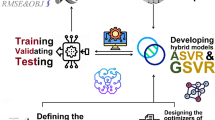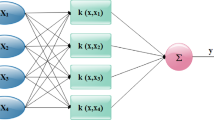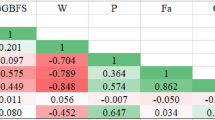Abstract
High-performance concrete (HPC) is one of the concrete types with high strength, good performance, and high durability, which has been considered in the structural industry. Testing and sampling this type of concrete to determine its mechanical properties is daunting and complex. In addition, human and environmental factors were significant in the preparation of samples, which was also time-consuming and energy-consuming. Artificial intelligence (AI) can be used to eliminate and reduce these factors. This article intends to use the machine learning (ML) method to forecast one of the HPC mechanical properties: compressive strength (CS). The experimental data set used from the published article includes 168 samples, of which 70% (118) of the sample belonged to training and 30% (50) to the testing phase. Least square support vector regression (LSSVR) is one of the ML models used for forecasting in this article. In addition, meta-heuristic algorithms have been utilized to obtain the target to improve the accuracy and reduce the error. Algorithms include Honey Badger algorithm (HBA), COOT optimization algorithm (COA), and generalized normal distribution optimization (GNDO). Combining the algorithms with the introduced model forms a hybrid format evaluated by metrics in the training and testing phases. By evaluating the hybrid models, it has been determined that they can forecast with high accuracy and are reliable. In general, the LSHB hybrid model obtained the highest R2 and the lowest error compared to other models.




Similar content being viewed by others
Data availability
The authors do not have permissions to share data.
References
Aïtcin P-C (1998) High performance concrete. CRC Press
Akopyan AV (2015) Geometry of the Cardioid. Am Math Mon 122:144–150
Alshihri MM, Azmy AM, El-Bisy MS (2009) Neural networks for predicting compressive strength of structural light weight concrete. Constr Build Mater 23:2214–2219
Benemaran RS, Esmaeili-Falak M (2020) Optimization of cost and mechanical properties of concrete with admixtures using MARS and PSO. Comput Concr 26:309–316. https://doi.org/10.12989/cac.2020.26.4.309
Bharatkumar B, Narayanan R, Raghuprasad B, Ramachandramurthy D (2001) Mix proportioning of high performance concrete. Cem Concr Compos 23:71–80. https://doi.org/10.1016/S0958-9465(00)00071-8
Cheng M-Y, Chou J-S, Roy AFV, Wu Y-W (2012) High-performance concrete compressive strength prediction using time-weighted evolutionary fuzzy support vector machines inference model. Autom Constr 28:106–115
Cheng H, Kitchen S, Daniels G (2022) Novel hybrid radial based neural network model on predicting the compressive strength of long-term HPC concrete. Adv Eng Intell Syst. https://doi.org/10.22034/aeis.2022.340732.1012
De Larrard F, Malier Y (2018) Engineering properties of very high performance concretes. High Perform Concr. CRC Press, pp 85–114
Hashim FA, Houssein EH, Hussain K, Mabrouk MS, Al-Atabany W (2022) Honey Badger algorithm: new metaheuristic algorithm for solving optimization problems. Math Comput Simul 192:84–110
Huang L, Jiang W, Wang Y, Zhu Y, Afzal M (2022) Prediction of long-term compressive strength of concrete with admixtures using hybrid swarm-based algorithms. Smart Struct Syst 29:433–444
Kapner DJ, Cook TS, Adelberger EG, Gundlach JH, Heckel BR, Hoyle CD et al (2007) Tests of the gravitational inverse-square law below the dark-energy length scale. Phys Rev Lett 98:21101
Khiabani MY, Sedaghat B, Ghorbanzadeh P, Porroustami N, Shahdany SMH, Yousef Hassani SN (2023) Application of a hybrid hydro-economic model to allocate water over the micro- and macro-scale region for enhancing socioeconomic criteria under the water shortage period. Water Econ Policy
Kisi O (2015) Pan evaporation modeling using least square support vector machine, multivariate adaptive regression splines and M5 model tree. J Hydrol 528:312–320
Kovačević M, Prištini S, Mitrovica K, Beogradu S, Ivanišević N, Dašić T et al (2016) Primjena neuronskih mreža za hidrološko modeliranje u krškom području 1:1–10
Kovačević M, Lozančić S, Nyarko EK, Hadzima-Nyarko M (2021) Modeling of compressive strength of self-compacting rubberized concrete using machine learning. Materials (bAsel) 14:4346
Lam L, Wong Y, Poon C (1998) Effect of fly ash and silica fume on compressive and fracture behaviors of concrete. Cem Concr Res 28:271–283. https://doi.org/10.1016/S0008-8846(97)00269-X
Lim C-H, Yoon Y-S, Kim J-H (2004) Genetic algorithm in mix proportioning of high-performance concrete. Cem Concr Res 34:409–420
Lyngdoh GA, Zaki M, Krishnan NMA, Das S (2022) Prediction of concrete strengths enabled by missing data imputation and interpretable machine learning. Cem Concr Compos 128:104414
Masoumi F, Najjar-Ghabel S, Safarzadeh A, Sadaghat B (2020) Automatic calibration of the groundwater simulation model with high parameter dimensionality using sequential uncertainty fitting approach. Water Supply 20:3487–3501. https://doi.org/10.2166/ws.2020.241
Naruei I, Keynia F (2021) A new optimization method based on COOT bird natural life model. Expert Syst Appl 183:115352
Nguyen H, Vu T, Vo TP, Thai H-T (2021) Efficient machine learning models for prediction of concrete strengths. Constr Build Mater 266:120950
Ni H-G, Wang J-Z (2000) Prediction of compressive strength of concrete by neural networks. Cem Concr Res 30:1245–1250
Paillisson J-M, Marion L (2001) Interaction between coot (Fulica atra) and waterlily (Nymphaea alba) in a lake: the indirect impact of foraging. Aquat Bot 71:209–216
Prasad BKR, Eskandari H, Reddy BVV (2009) Prediction of compressive strength of SCC and HPC with high volume fly ash using ANN. Constr Build Mater 23:117–128
Russell HG (1999) ACI defines high-performance concrete. Concr Int 21:56–57
Sarkhani-Benemaran R, Esmaeili-Falak M, Javadi A (2022) Predicting resilient modulus of flexible pavement foundation using extreme gradient boosting based optimised models. Int J Pavement Eng. https://doi.org/10.1080/10298436.2022.2095385
Sobhani J, Najimi M, Pourkhorshidi AR, Parhizkar T (2010) Prediction of the compressive strength of no-slump concrete: a comparative study of regression, neural network and ANFIS models. Constr Build Mater 24:709–718
Suykens JAK, De Brabanter J, Lukas L, Vandewalle J (2002) Weighted least squares support vector machines: robustness and sparse approximation. Neurocomputing 48:85–105
Topcu IB, Sarıdemir M (2008) Prediction of compressive strength of concrete containing fly ash using artificial neural networks and fuzzy logic. Comput Mater Sci 41:305–311
Yeh I-C (1998) Modeling concrete strength with augment-neuron networks. J Mater Civ Eng 10:263–268. https://doi.org/10.1061/(ASCE)0899-1561(1998)10:4(263)
Yin H, Liu S, Lu S, Nie W, Jia B (2021) Prediction of the compressive and tensile strength of HPC concrete with fly ash and micro-silica using hybrid algorithms. Adv Concr Constr 12:339–354
Zhang J, Li D, Wang Y (2020a) Toward intelligent construction: prediction of mechanical properties of manufactured-sand concrete using tree-based models. J Clean Prod 258:120665
Zhang Y, Jin Z, Mirjalili S (2020b) Generalized normal distribution optimization and its applications in parameter extraction of photovoltaic models. Energy Convers Manag 224:113301
Funding
This work was supported by the Development and Application of an Intelligent Park Operation Management System based on BIM Technology (No. JC2021173).
Author information
Authors and Affiliations
Contributions
GY: methodology, formal analysis, software, validation. XW: writing—original draft preparation, conceptualization, supervision, project administration. WZ: software, formal analysis, methodology, language review. YB: writing—original draft preparation, methodology, software, language review.
Corresponding author
Ethics declarations
Conflict of interest
The authors declare no competing interests.
Additional information
Publisher's Note
Springer Nature remains neutral with regard to jurisdictional claims in published maps and institutional affiliations.
Rights and permissions
Springer Nature or its licensor (e.g. a society or other partner) holds exclusive rights to this article under a publishing agreement with the author(s) or other rightsholder(s); author self-archiving of the accepted manuscript version of this article is solely governed by the terms of such publishing agreement and applicable law.
About this article
Cite this article
Yan, G., Wu, X., Zhang, W. et al. An explanatory machine learning model for forecasting compressive strength of high-performance concrete. Multiscale and Multidiscip. Model. Exp. and Des. 7, 543–555 (2024). https://doi.org/10.1007/s41939-023-00225-1
Received:
Accepted:
Published:
Issue Date:
DOI: https://doi.org/10.1007/s41939-023-00225-1




